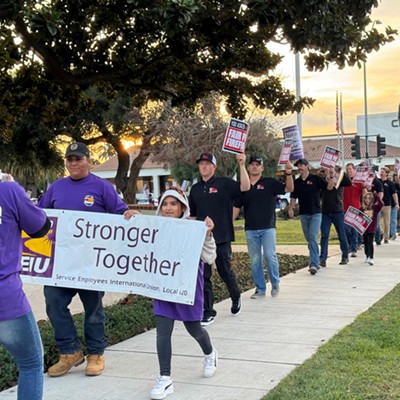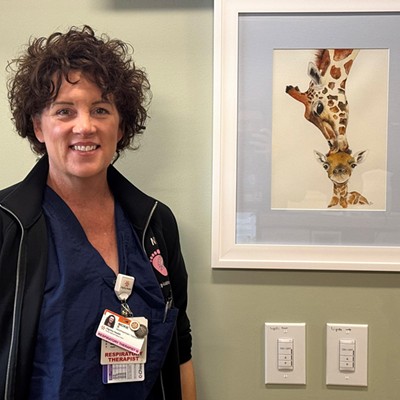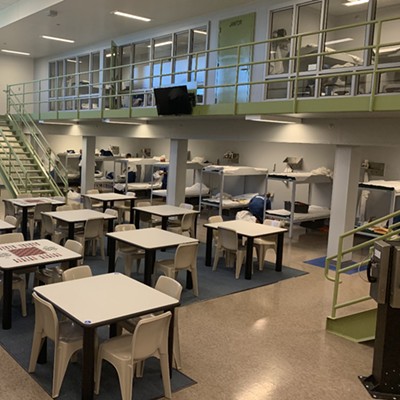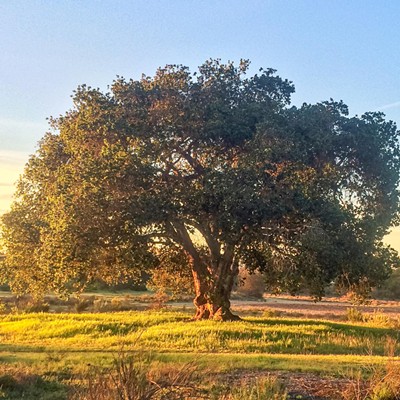Outside the Bridgehouse Homeless Shelter in Lompoc, 18 8-by-8-foot sheds sit on freshly laid asphalt in a circle. Beds, flowers, a bag of snacks, and water inside each welcome their guests. Picnic tables sit under the shaded middle of the neighborhood with potted plants scattered around.
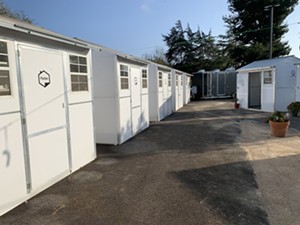
The white buildings—which will be painted purple, red, and orange—are part of the Good Samaritan Shelter’s 90-day Pallet sheltering program designed to help the homeless population with mental illnesses or social anxieties, among other issues. The 64-square-foot shelters are made by Pallet, a Washington-based company, and are designed to be set up quickly—some in less than an hour.
“It’s the perfect opportunity to reach an unreachable cross-section of homeless that would not come into a shelter,” said Brian Halterman, Good Samaritan’s Lompoc homeless and housing program director.
Halterman and his team hosted a preview of the Pallet shelters on Aug. 26. The program will begin in mid-September and will stay in Lompoc for the long term, Halterman said at the event.
Good Samaritan executive board member Tom Jenkins said that working with partners in the county enables the organization to help the community.
“We really appreciate all the county work that went behind this,” Jenkins said. “This really is a great opportunity, and it will have a major impact.”
Good Samaritan has served the homeless population in Santa Maria since 1987, with its Lompoc shelter opening in 2006. Its mission is to provide emergency, transitional, and affordable housing along with support services to the homeless and those in recovery throughout the Central Coast.
Lompoc’s new Pallet sheltering program follows a similar program in Isla Vista that had 20 shelters and assisted 40 people through the 90-day program, with 24 of its residents moving into permanent housing and the others moving to Hedges House of Hope.
Halterman said Good Samaritan’s team and county partners wanted to continue the use of the Pallet shelters and turned to Lompoc because the city has dealt with recurring issues within the Santa Ynez Riverbed.
In 2018, Lompoc City Council approved a half-million-dollar contract to clean up the riverbed by removing more than a million pounds of debris and providing 90-day eviction notices to the large homeless population residing there, said Lompoc Mayor Janelle Osborne.
“The problem is that the prior council did not choose to maintain the cleanup,” she said. “You can’t do a cleanup and eviction project without enough housing.”
Four years later, numbers are climbing again, Osborne said.
According to 2020 Santa Barbara County data, the city of Lompoc has a total of 211 unsheltered people in the area.
Osborne said there will be another cleanup that follows the 2018 model, but this time around there’s a Pallet sheltering option provided.
Pallet sheltering funding came from the state-initiated Homeless Emergency Aid Program (HEAP), said Santa Barbara County Homeless Assistance Programs Manager Kimberlee Albers. The dollars went through Santa Barbara County to Good Samaritan to pay for the 20 shelters from Isla Vista, a shower and bathroom trailer, its transportation to Lompoc, and other miscellaneous services, such as electricity and pavement, for the Lompoc site.
Although Albers said she believes Pallet housing is a step in the right direction, “It’s not good that people have to live in Pallets and not apartments. We have to realize the primary reason people experience homelessness is a lack of affordable housing.”
Average rent in Lompoc is around $1,613 per month, a 9 percent increase over last year, according to rentcafe.com.
“It’s easy to point fingers and make it about the person, but it really is about a system that is spiraling and rents continuing to soar,” she said.
Albers said she commends the Board of Supervisors for leading on this issue, identifying sites, and putting projects in the pipeline.
Fourth District Supervisor Bob Nelson was a key actor in this project, Halterman said.
Nelson spoke at the preview event, commending the project.
“The county is continuing to lean on the people of Good Samaritan more and more, and I’m just glad they have broad shoulders. There’s a lot of money coming this way and we have to make sure we are effectively using that to get the most we can from this [program],” Nelson said. “This window is not going to be around forever, it’s just the issue of the day. We need to strike while the iron is hot, make sure we fill capacity, change lives, and hopefully bend a curve that we’ve had in our community for a long time.”
Nelson said Lompoc and the county are ahead of the game in terms of combatting this issue by providing Pallet sheltering and a group shelter on one campus, creating a unique community.
The Pallet sheltering provides the same number of resources and connections to individuals as those staying in dorm-like facilities, Halterman said. Those entering the shelter will speak with a base manager who will connect them with community partners that are critical to the 90-day program. The biggest service is getting everyone “document-ready.”
Oftentimes, people don’t have the appropriate paperwork to apply for housing once an opportunity arrives, Halterman explained. Good Samaritan helps people get all of their information into one place so they can move into a permanent setting of their own as well as provides services to help their overall well-being, he said.
The county Department of Behavioral Wellness links each person to services like psychological and psychiatric assessments, medication management, therapy services, and case management. Each service—and the frequency of help provided—is individualized based on the person’s needs, said Suzanne Grimmesey, a public information officer with the Department of Behavioral Wellness.
“Our partnership becomes critical to keep the flow of services and connections going to serve mental health needs,” she said.
The array of services provided is important to Santa Barbara County Deputy Probation Officers Bonnie O’Neill and Monica Hernandez, who often work with people found in situations at the Santa Ynez Riverbed and make referrals to Good Samaritan.
The two probation officers visited the preview and said they are both pleased to see Pallet shelters coming to Lompoc.
“It’s a great option when we have a clientele that needs help with permanent housing; specifically, those with mental health issues who may feel overwhelmed or anxious in larger settings. This way, they can be alone and still in a safe space,” O’Neill said.
O’Neill said they frequently find that clients who would rather be alone go into the riverbed, which isn’t safe due to violence among other issues. By attending the Pallet sheltering preview, both probation officers said they feel equipped with enough information to point their clients in Good Samaritan’s direction.
While probation officers can make referrals, the selection process has not been clarified yet nor have potential residents been selected for the Pallet shelters. Halterman said it will be an “equitable process,” with low barriers decided in conjunction with community partners in order to find those best suited for this living situation.
“These Pallet shelters are going to give us the opportunity with Good Sam to serve 20 to 30 people in a way that many traditionally will not enter our shelter systems,” Halterman said. “They may come in for those 90 days, engage with drug treatment and mental health services. We can help move through the process from being without a home to having a place to call their own.”
Reach Staff Writer Taylor O’Connor at [email protected].


